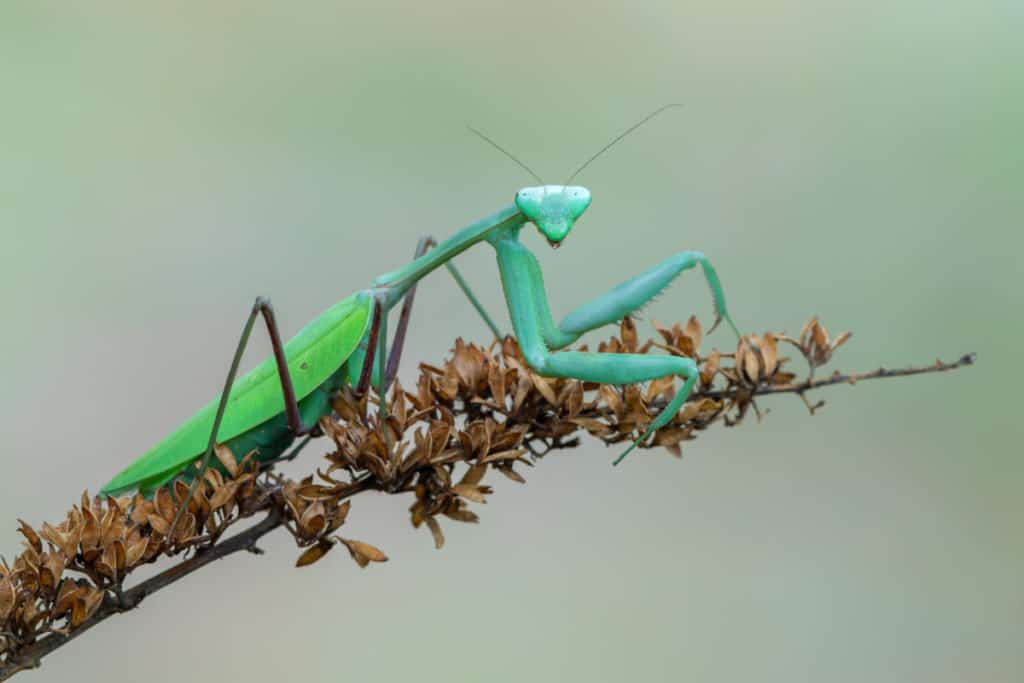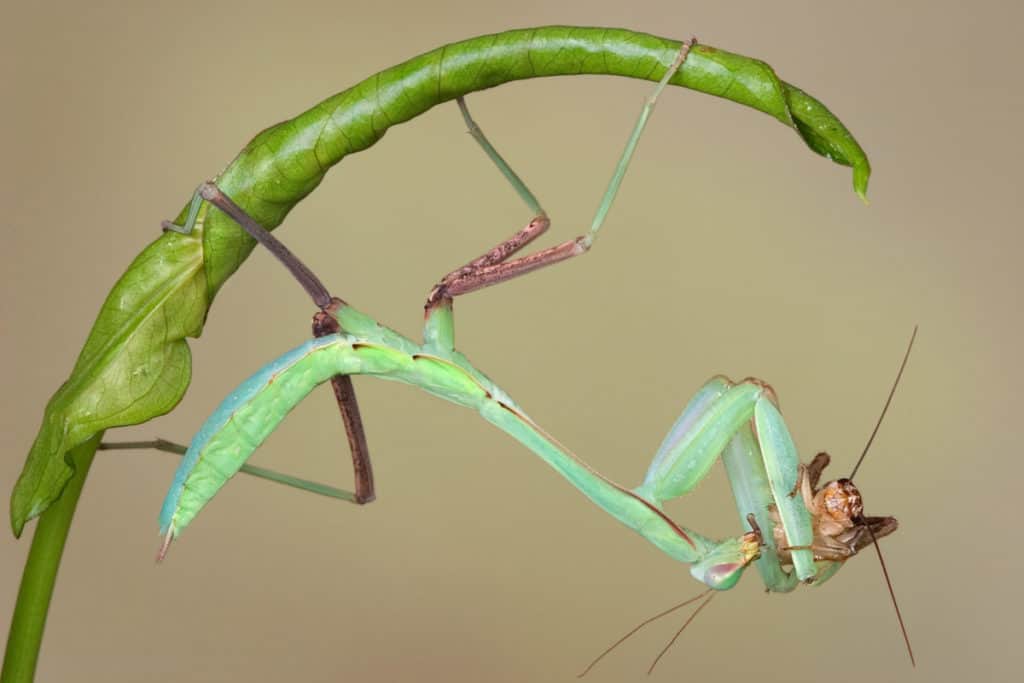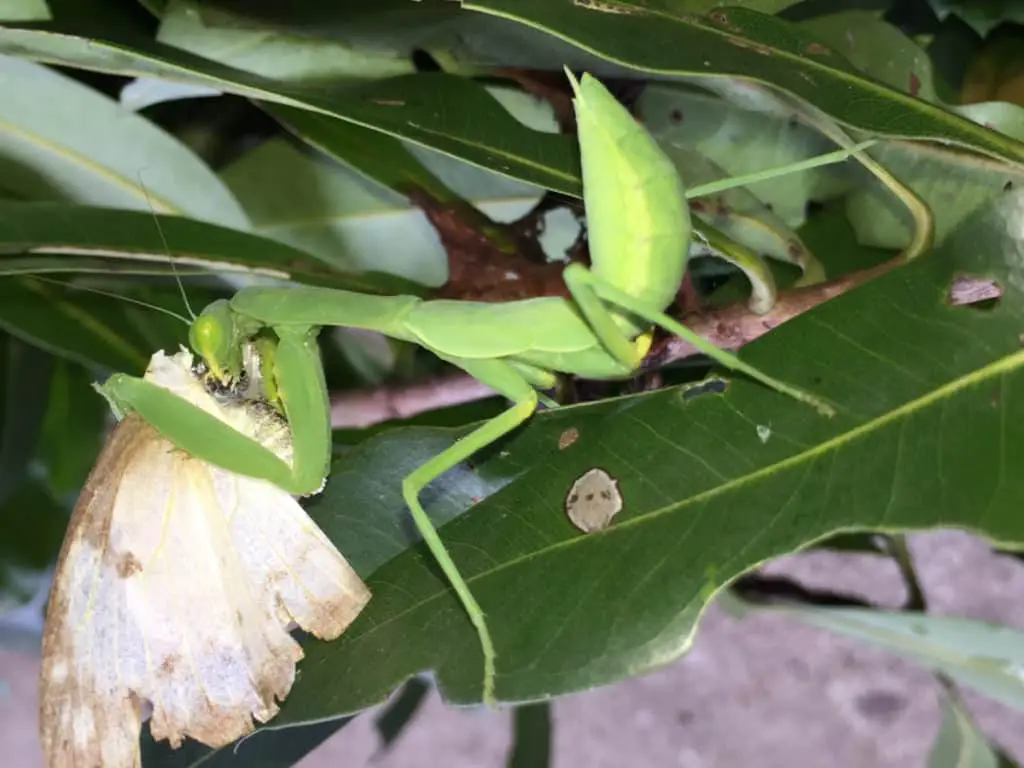With an appearance like nothing else on earth, part stick insect, part Buddhist monk, the Giant Asian mantis is a fascinating species belonging to the praying mantis family.
With the common name of giant Asian Mantis, under the genus “Hierodula”, there are a variety of numerous large species that live across many countries in Asia including; Malaysia, Myanmar, Thailand, Hawaii, Nepal, India, Philippines, New Guinea, Sri Lanka, Southern China, and Vietnam among others. They are also found in parts of Japan such as Honshu, Shikoku, Kyushu, and Okinawa.

One of the largest giant Asian praying mantes is the Indian mantis, Hierodula Membranacea. It can be found in Southeast Asia in hot and humid climates where the temperature ranges between 22 to 30 degrees Celsius. Humidity in these regions is usually high at 60% to 70%.
Here we will explore some popular Hierodula varieties that are attractive as exotic pets in many parts of the world. They all share the common name giant Asian mantis although they may differ in some aspects. Generally, their care requirements in captivity are somewhat the same.
Distribution
Apart from the continent that gave the insect its name, the giant Asian mantis can be also found in many other regions worldwide. They can be found in the United States and many countries in the western hemisphere where they are kept as pets.
Traders in pets breed them in captivity quite successfully since there is a big demand for these colorful, attractive creatures. Giant Asian mantids are not considered to be an endangered species. They thrive very well both in their natural habitats and in captivity.
Selling Giant Asian mantids is a legal and legitimate trade that is carried out by pet shops and breeders. Giant Asian mantises are not demanding in their care as pets and can be reared with ease by hobbyists.
Some widespread varieties of the giant Asian mantis species are:
- Hierodula Membranacea
- Hierodula Patellifera
- Titanodula Grandis
Appearance
While the giant Asian mantis is usually green in color, there are also yellow, beige, and brown varieties. The color range of this species can be fairly diverse from yellowish-green to reddish-brown and the rare silvery-white of the giant Indian mantis.
Adult females are bigger and bulkier than males, with wings that extend just to the abdomen.
Hierodula Membranacea
Females can reach about 3 to 5 inches (8 -9 centimeters). The males are a bit smaller measuring about 3 inches (7 -8 centimeters) and they can be identified from the females by their eight abdominal segments. Females have six abdominal segments.
This species can be light brown, grass green, or yellowish in color. It is an aggressive predator that can eat other mantids in captivity when placed in the same enclosure.
Hierodula Patellifera
This species belongs to the genus Hierodula. It also goes by the common name giant Asian mantis, Indochina mantis, or Harabiri mantis. It can be found at the edges of forests in trees and in grasslands. This variety is common in Japan as well as other Asian countries.
It comes in light green, turquoise, or brown colors. Females can grow up to 7 centimeters while males are 6 centimeters.
Titanodula Grandis
This species is also among the giant Asian mantis variety in the genus Titanodula. It is native to the southern Asia region around the Bay of Bengal and it can also be found in Northeast India, Myanmar, and Bangladesh. It is a gigantic creature in the world of Mantids. it can grow up to 6 inches long and has an exceptionally heavy build, thus its name.
The adult female has a much larger abdomen in comparison to the male. Due to his smaller body, the male appears to have longer wings.
What Does The Giant Asian Mantis Eat?
Generally, the Giant Asian mantis is not a picky eater in the wild and it has a wide range of prey options in its natural habitat. However, they eat voraciously and their diet includes crickets, moths, cockroaches, and grasshoppers when we keep them as pets.
While in the nymphal stage, they usually eat blue bottle flies and fruit flies among other small insects. As pets, they should not be fed bees or wasps as this may not be safe for them.
Nymphs can be fed a day or two after emerging. From the nymphal stage, their diet changes as they get older as indicated below.
- L1 to L2 nymphs: should be fed blue bottle flies , pinhead crickets or fruit flies.
- L3 to L5 nymphs: should be fed house flies, blue bottle flies and small cockroaches
- L6 nymphs : should be fed blue bottle flies and large cockroaches or locusts.

In the wild, Titanodula Grandis is capable of capturing and eating small birds, reptiles, and mammals due to its size and appetite. When kept as pets, care must be taken not to overfeed the Mantids since this could harm them. They have a tendency to overfeed if food is available throughout. If you observe that their abdomen is very big because of constant feeding, you should stop feeding for a day or two.
Allowing them to overindulge is not good for their metabolism in the long run. It is recommended that feeder Insects or prey should be about 1/3 of the size of the mantis. The giant Asian species is not intimidated by large prey; it can grab and eat prey as big as itself.
Cannibalism
The giant Asian mantis is quite an aggressive predator and will eat other members of its species, especially when in captivity or in the early stages of life. Nymphs are voracious eaters and can eat each other.
Due to their highly aggressive behavior towards each other, when in captivity only groups up to L3/L4 can be housed together. Adult males may also be housed in groups without too much risk of them turning on each other. In captivity, sexual cannibalism, where the female eats her mate, can occur.
In order to avoid this, the female should be fed before the male is introduced into the enclosure or cage. After successful mating, which can take hours, the male will usually run away to avoid being eaten and should be removed at once.
How Do They Hunt Prey?
Giant Asian mantids are fierce hunters that will actively go after their prey once they spot it. They don’t always sit and wait to ambush prey.

They will go after anything half their own body size or smaller and are not intimidated. They use their spiked forelegs to catch and hold prey and they only eat live prey.
Threat Display
When under threat by predators, giant Asian mantis will adopt a threat display by rearing back with its wings and forelegs spread and mouth open.
This posture makes the mantis appear much larger and is meant to scare off the threat. If the display does not deter the predator from advancing, the mantis will strike out with its forelegs and bite. This is a defensive attack that can break the skin and is painful. The giant Asian mantis’ bulk and size enable it to defend itself better than most other praying mantis species.
The Life Cycle Of The Giant Asian Mantis
On average the female giant Asian mantids live for one to two years in captivity. Males can generally live for 18 months. In the wild, their average lifespan is about six months.
Life begins at the egg stage with the female laying eggs in an ootheca. She will produce around 5 to 8 ootheca. This is an egg-mass capsule that can hold 100 to 150 eggs for these species. The female mantis attaches the protective ootheca to a plant stem or twig.
The eggs hatch after 4 – 6 weeks of incubation. The nymphs that emerge (L1) are quite voracious and eat all species of fruit fly and blue bottle fly. When they are a little older they will eat small crickets, grasshoppers, and flies.
The giant Asian mantis, like all other Mantid species, undergoes incomplete metamorphosis whereby; they don’t go through the pupal stage. They are hemimetabolic meaning that they go through three stages in life: egg, nymph, and adult.
The nymphs hatch as tiny replicas(L1) of the adult mantids and as they grow up they shed their exoskeleton by molting.
If you would like to know more about the diets of praying mantis then check out this article we have written, What Does A Praying Mantis Eat?
Mating
Giant Asian Mantids can be mated two weeks after the final molt. But nevertheless, it is a good idea to wait until after 4 weeks when the female is more receptive.
Feeding the female well prior to mating reduces the chances of the female eating the male before or during mating. Offering a prey item to the female keeps her busy eating while the male is introduced into the cage behind her and if he is ready, he will jump on her back. As she is busy with her prey, she can’t grab him or throw him off of her.
After holding on for a while, the male will get confident enough to bend his abdomen down to connect with hers and mating will commence. Once the mating comes to an end, which can vary in the time it takes and can last many hours, the male will run away or else he’ll be eaten. That is the time to go to his rescue and remove him.
In their natural tropical environment, they can mate at any time almost throughout the year because weather conditions do not change widely as is the case in temperate regions.
How Many Molts To Adulthood?
A young giant Asian mantis molts after every two weeks. As they progress in age, the time between each molt increases and it can sometimes extend up to 3-4 weeks. For males and females, 7 molts occur before they reach adulthood.
To ensure that the molting process happens correctly and well, it is vital that the Mantids are not disturbed. Mantids will usually stop eating a day or 2 (or even a bit longer) just before molting.
The correct humidity level is important during the process of molting. Too much humidity can interfere with the proper drying out of the insect which can end up with bent legs and crippled arms. Make sure that the humidity level is at 60%. Once molted, you can wait for a day or two before feeding the mantis again.
The Giant Asian mantis goes through all the stages of development and molting regardless of whether they are in captivity or in the wild. There is not much difference in the basic natural changes and growth. Having said that, temperature, availability of food, and environment have an impact that can affect the mantises health, development, or lifespan.
At L3 to L5 stages, nymphs are ready to become pets. The Giant Asian mantis is a fairly easy and straightforward pet even for beginners to manage and take care of.
Keeping A Gaint Asian Mantis As A Pet
Like caring for any pet you need to be prepared. For any praying mantis, you need to prepare an environment that is sustainable, natural, and comfortable for them. Let’s take a look at what this needs to look like.
Accommodation
You can keep a giant Asian mantis in a screen or mesh cage because it helps in maintaining the proper humidity level. Other types of enclosures can be used but you should ensure adequate ventilation with plenty of room for the mantis to roam-as an active predator it needs space.
The well-ventilated cage should have thick twigs of one to two centimeters placed horizontally for the mantis to perch on. You can place a potted plant in the cage such as an Ivy branch, leafy branch, orchid flower, or white flower. However, be careful not to introduce pesticides into the cage by accident.
A substrate is important in maintaining the correct humidity inside the cage. You can use soil, sand, kitchen paper, gravel or coco humus can be used since the creatures hardly ever stay on the ground. The cage can be sprayed with distilled water every other day. Avoid using tap water, because of the chemical in it, and use spring or distilled water instead.
The substrate should be easily disposable and needs to be changed frequently. When cleaning the enclosure use vinegar or biodegradable glass cleaner and afterward rinse thoroughly with clean water.
As a minimum, the size of the enclosure should be at the least, 3x length, width, and height of the mantid’s length. This means that a 1-inch mantis should be kept in enclosures of not less than 3x3x3 inches. Mantises spend most of their time hanging upside down from the top of their enclosures.
Burlap or other suitable material can be tied around the twigs inside the enclosure or cap to provide a good secure surface for the mantis to hang from during molting.
Temperature And Humidity
The ideal temperature for these tropical insects is around 21 -30 degrees Celsius. Extreme cold or heat could kill the mantis and should be avoided. Too warm temperature speeds the metabolism and shortens the lifespan of the mantis.
Cool temperatures at night, however, slow down their metabolism and help the mantis to live longer. During winter, a heat lamp may be used to maintain the desired temperature in the enclosure.
Humidity in the tropics can be as high as 70% in the natural habitat of giant Asian mantis. In captivity, the right humidity is flexible and should be kept at between 40 % and 60% relative humidity (RH).
When humidity is too high, it can cause fungal growths which are not a healthy situation for the mantis and can be fatal. On the other hand, too little humidity can cause a bad shed during molting.
Are Giant Asian Mantis Dangerous As Pets?
Giant Asian Mantids are not dangerous to humans as pets and they don’t have any venom as a defensive option. However, they are capable of puncturing your skin with a painful strike.
Their spiked forelegs are the only defense apart from camouflage, but they don’t behave aggressively towards humans unless provoked. The only danger they pose is towards members of their own species!
Praying mantis does have a bite capable of tearing their prey apart. Check out this article we have written to find out more, Do Praying Mantis Bite?
Giant Mantis Summary Table
| Color | Can vary from light brown, grass green, yellowish, beige |
| Size | Females are larger at 8 – 9 cm. Males are smaller at 7- 8cm. Females of the largest species can reach up to 10 cm. |
| Diet | Voracious eaters; Eats live prey crickets, grasshoppers, blue bottle flies, fruit flies, small birds, small mammals, frogs. |
| Lifespan | In captivity, the average is one year, but they can live for longer up to 18 months. Females live longer than males. Lifespan in the wild is about 6months |
| Metamorphosis | They undergo incomplete metamorphosis. |
| Availability as pets | Available from pet shops. Are in high demand because of their vibrant colors and large size. It is not an endangered species. |
| Aggressiveness | Very aggressive towards each other, especially females towards males. They cannot live communally in captivity. |
| Harmless | Despite their large size, they are harmless to humans |
The Wrap Up
The giant Asian mantis is a beautifully diverse but closely related species that is sought after as an exotic pet in the western hemisphere. It is valued by pet traders and breeders alike for its vibrant colors and large size.
Its natural habitats in Asia are still intact and offer a conducive environment for the species to continue thriving. With the correct know-how and enclosures, one can breed Giant Asian Mantis in captivity.
They are not considered an endangered species.
Want to know about some other species of praying mantis? Check out the other article we have written below:
The Devil’s Flower Mantis: Your Complete Guide
The Budwing Mantis: Your Complete Guide
The Spiny Flower Mantis: Your Complete Guide
The Ghost Mantis: Your Complete Guide
Sources
https://pearsonsreptiles.wordpress.com/hierodula-membranacea/
https://www.mantidsandmore.com/lexicon/hierodula-membranacea/
https://www.mantisplace.com/mantiscaresheets
https://en.m.wikipedia.org/wiki/Hierodula_membranacea
https://www.mantidsandmore.com/lexicon/hierodula-patellifera/
https://usmantis.com/collections/genus-hierodula-giant-asian-mantis
https://www.panterrapets.com/pages/giant-asian-mantis-caresheet
https://mantidkingdom.com/mantid-care/hierodula-membranacea/
https://www.keepinginsects.com/praying-mantis/species/giant-asian-mantis/
